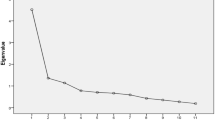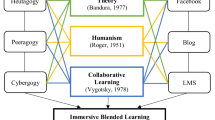Abstract
Higher education is moving towards digitalized learning. The rapid development of technological resources, devices and wireless networks enables more flexible opportunities to study and learn in innovative learning environments. New technologies enable combining of authentic and virtual learning spaces and digital resources as multifunctional learning platforms. In the development process it is important to ensure that the quality of environment and the pedagogical suitability are high in relation to the intended learning outcome. The quality of the learning environment can be assessed, for example, from students’ levels of satisfaction. In this study a satisfaction is proposed by following aspects: instruction and feedback, pedagogical and technological methods, perceived enjoyment and self-motivation. The aim of this study was to compare the students’ satisfaction with a ubiquitous learning environment based on 360o–technology and a traditional web-based online learning environment. A comparative, quasi-experimental study design was used. 115 students assigned on clinical histology and histotechnology course and voluntarily to the study, 61 students were assigned to an experimental group and 54 to a control group. The experimental group studied via a 360o–ubiquitous learning environment (ULE) and the control group via a web-based online course (WLE). Satisfaction was assessed at the end of studies by using an instrument developed for this study. The instrument measured aspects affecting the perceived satisfaction by 25 items (Likert 1–5) and 2 open-ended questions. The data was analysed by using the Mann Whitney U-test and with an inductive content analysis. Students in both groups were highly satisfied in the use of the learning environments. Used pedagogical and technological methods were assessed as high. The environments were assessed as easy to use and re-use. Diverse, interesting and clear learning content was seen as highly positive. Statistically significant difference between groups were seen in aspect concerning instruction and feedback. Other significant differences were not seen between groups. Developmental needs were seen in instruction and feedback aspect. More structured course planning, more supportive supervision and technical support were pointed out. The results suggest that ubiquitous learning environments should be used as supportive in histology and histotechnology studies. The results also indicated that the further development and optimisation of the learning environment should be done.






Similar content being viewed by others
References
Arbauch, J. B. (2000). Virtual classroom characteristics and student satisfaction with internet-based MBA courses. Journal of Management Education, 24(1), 32–54.
Arbauch, J. B., & Duray, R. (2002). Technological and structural characteristics, student learning and satisfaction with web-based courses. An exploratory study of two on-line MBA programs. Management Learning, 33(3), 331–347.
Aycock, A., Garnham, C. & Kaleta, R. (2002). Lessons learned from the hybrid course project. Teaching with Technology Today, 8.
Bastanlar, Y. (2007). User Behaviour in Web-Based Interactive Virtual Tours. In Proceedings of 29th International Conference on Information Technology Interfaces, doi:10.1109/ITI.2007.4283774
Bonk, C. J., Olson, T. M., Wisher, R. A. & Orvis, K. L. (2002). Learning from focus groups: An examination of blended learning. Journal of Distance Education, 17(3), 97–118.
Butt, B., & Rehman, K. (2010). A study examining the student’s satisfaction in higher education. Procedia Social and Behavioral Sciences. doi:10.1016/j.sbspro.2010.03.888.
Chu, H.C. (2014). Potential negative effects of mobile learning on student’s learning achievement and cognitive load - A format assessment perspective. Educational Technology and Society, http://www.jstor.org/stable/jeductechsoci.17.1.332.
Chu, H. C., Hwang, G. J., & Tsai, C. C. (2010). A knowledge engineering approach to developing mindtools for context-aware ubiquitous learning. Computers & Education. doi:10.1016/j.compedu.2009.08.023.
Davies, M. (2014). Using the apple iPad to facilitate student-led group work and seminar presentation. Nurse Education in Practice. doi:10.1016/j.nepr.2014.01.006.
Elo, S., & Kyngäs, H. (2008). The qualitative content analysis process. Journal of Advanced Nursing. doi:10.1111/j.1365-2648.2007.04569.x.
Eom, S., Wen, J., & Ashill, N. (2006). The determinants of students perceived learning outcomes and satisfaction in university online education: An empirical investigation. Decision Sciences Journal of Innovative Education. doi:10.1111/j.1540-4609.2006.00114.x.
Giese, J. L., & Cote, J. A. (2002). Defining consumer satisfaction. Academy of Marketing Science Review, 2000(1), 1–24.
Henning-Thurau, T., & Klee, A. (1997). The impact of customer satisfaction and relationship quality on customer retention: A critical reassessment and model development. Psychology & Marketing, 14(8), 737–764.
Huang, Y-M., Huang, T-C., & Hsieh, M-Y. (2008). Using annotation services in a ubiquitous Jigsaw cooperative learning environment. Educational Technology & Society, http://www.jstor.org/stable/jeductechsoci.11.2.3
Huang, Y.-M., Chiu, P.-S., Liu, T.-C., & Chen, T.-S. (2011). The design and implementation of a meaningful learning-based evaluation method for ubiquitous learning. Computers & Education. doi:10.1016/j.compedu.2011.05.023.
Hwang, G.J., Tsai, C.C. & Yang, S.J.H. (2008). Criteria, Strategies and Research Issues of Context-Aware Ubiquitous Learning. Educational Technology & Society, http://www.jstor.org/stable/jeductechsoci.11.2.81
Hwang, G.-J., Yang, T.-C., Tsai, C.-C., & Yang, S. J. H. (2009). A context-aware ubiquitous learning environment for conducting complex science experiments. Computers & Education. doi:10.1016/j.compedu.2009.02.016.
Hwang, G., Wu, P., Zhuang, Y., & Huang, Y. (2011a). Effects of the inquiry-based mobile learning model on the cognitive load and learning achievement of students. Interactive Learning Environments. doi:10.1080/10494820.2011.575789.
Hwang, G. J., Wu, C. H., Tseng, J. C. R., & Huang, I. W. (2011b). Development of a ubiquitous learning platform based on a real-time help-seeking mechanism. British Journal of Educational Technology. doi:10.1111/j.1467-8535.2010.01123.x.
Jones, K., & Chen, C. (2008). Blended learning in a graduate accounting course: Student satisfaction and course design issue. The Accounting Educators Journal, XVIII, 15–28.
Jones, V. & Jo, J.H. (2004). Ubiquitous learning Environment: An adaptive teaching system using ubiquitous technology. In Atkinson, R., McBeath, C., Jonas-Dwyer, D. & Phillips, R. (Eds), Beyond the comfort zone: Proceedings of the 21st ASCILITE Conference, pp. 468–474. Perth.
Jung, H. (2014). Ubiquitous learning: Determinants impacting learners’ satisfaction and performance with smartphones. Language Learning & Technology, 18(3), 97–119 EISSN-1094-3501.
Kurtulus, A. (2013). The effects of web-based interactive virtual tours on the development of prospective mathematics teachers´ spatial skills. Computers & Education. doi:10.1016/j.compedu.2012.11.009.
Lim, H., Lee, S.-G., & Nam, K. (2007). Validating e-learning factors affecting training effectiveness. International Journal of Information Management. doi:10.1016/j.ijinfomgt.2006.08.002.
Liu, Y. (2010). Social media tools as a learning resource. Journal of Educational Technology Development and Exchange, 3(1), 101–114.
Liu, G. Z., & Hwang, G. J. (2009). A key step to understanding paradigm shifts in e-learning. British Journal of Education Technology. doi:10.1111/j.1467-8535.2009.00976.x.
Looney, C. A., Jessup, L. M., & Valacich, J. S. (2004). Emerging business models for mobile brokerage services. Communications of the ACM. doi:10.1145/990680.990683.
Louvre Museum. (2007). Virtual tour. http://musee.louvre.fr/visite-louvre/index.html?defaultView=entresol.s489.p01&lang=ENG
Margaryan, A., Littlejohn, A., & Vojt, G. (2011). Are digital natives a myth or reality? University students´ use of digital technologies. Computers & Education. doi:10.1016/j.compedu.2010.09.004.
Marinagi, C., Skourlas, C., & Belsis, P. (2013). Employing ubiquitous computing devices and Technologies in the Higher Education Classroom of the future. Procedia-Social and Behavioral Sciences. doi:10.1016/j.sbspro.2013.02.081.
Martin, F., & Ertzberger, J. (2013). Here and now mobile learning: An experimental study on the use of mobile technology. Computers & Education. doi:10.1016/j.compedu.2013.04.021.
Naaj, M. A., Nachouki, M., & Ankit, A. (2012). Evaluating student satisfaction with blended learning in a gender-segregated environment. Journal of Information Technology Education: Research, 11. ISSN-1547-9714.
Navarro, M. M., Iglesias, M. P., & Torres, P. R. (2005). A new management element for universities: satisfaction with the offered courses. International Journal of Educational Management, 19(6), 505–526.
Novo-Corti, I., Varela-Candamio, L., & Rami-Diaz, M. (2013). E-learning and face to face mixed methodology: Evaluating effectiveness of e-learning and perceived satisfaction for microeconomic course using the Moodle platform. Computers in Human Behaviour. doi:10.1016/j.chb.2012.06.006.
Ogata, H., & Yano, Y. (2004). Knowledge awareness map for computer-supported ubiquitous language-learning. Proceedings of the International Workshop on Wireless and Mobile Technologies in Education. doi:10.1109/WMTE.2004.1281328.
Ogata, H., Paredes, J. R. G., Saito, N. A., San Martin, G. A., & Yano, Y. (2008). Supporting classroom activities with the BSUL system. Educational Technology & Society. doi:10.1109/WMTE.2005.61.
Owston, R., York, D., & Murtha, S. (2013). Student perceptions and achievement in a university blended learning strategic initiative. Internet and Higher Education. doi:10.1016/j.iheduc.2012.12.003.
Parker, C., & Mathews, B. P. (2001). Customer satisfaction: contrasting academic and consumers’ interpretations. Marketing Intelligence & Planning, 19(1), 38–44.
Piccoli, G., Ahmad, R., & Ives, B. (2011). Web-based virtual learning environments: A research framework and a preliminary assessment of effectiveness in basic IT skill training. MIS Quarterly, 25(4), 401–426.
Potkonjak, V., Gardner, M., Callaghan, V., Mattila, P., Guetl, C., Petrovic, V. M., & Jovanovic, K. (2016). Virtual laboratories for education in science, technology, and engineering: A review. Computers and Education. doi:10.1016/j.compedu.2016.02.002.
Rahman, N., Hussein, N., & Aluwi, A. (2015). Satisfaction on blended learning in a public higher education institution: What factors matter? Procedia- Social and Behavioral Sciences. doi:10.1016/j.sbspro.2015.11.107.
Ramayah, T., & Lee, J. (2012). System characteristics, satisfaction and E-learning usage: A structural equation model (SEM). TOJET: The Turkish Online Journal of Educational Technology, 11(2), 197–206.
Ray, S., Koshy, N., Reddy, P., & Srivastava, S. (2012). Virtual labs in proteomics: New E-learning tools. Journal of Proteomics. doi:10.1016/j.jprot.2012.03.014.
Sakamura, K., & Koshizuka, N. (2005). Ubiquitous computing Technologies for Ubiquitous Learning, proceedings of the 2005 I.E. international workshop on wireless and mobile Technologies in Education (WMTE ‘05). doi:10.1109/WMTE.2005.67.
Small, F., Dowell, D. & Simmons, P. (2012). Teacher communication preferred over peer interaction: student satisfaction with different tools in a virtual learning environment. Journal of International Education in Business, 5(2), 114–128.
So, H.-J., & Brush, T. (2008). Student perceptions of collaborative learning, social presence and satisfaction in a blended learning environment. Relationships and critical factors. Computers & Education. doi:10.1016/j.compedu.2007.05.009.
Sun, P.-C., Tsai, R. J., Finger, G., Chen, Y.-Y., & Yeh, D. (2008). What drives a successful e-learning? An empirical investigation of the critical factors influencing learner satisfaction. Computers & Education. doi:10.1016/j.compedu.2006.11.007.
Tatli, Z. & Auas, A. (2013). Effect of a Virtual Chemistry Laboratory on Student’s achievements. Educational technology & Society, http://www.jstor.org/stable/jeductechsoci.16.1.159
Vygotsky, L. (1978). Interaction between learning and development. In Gauvain & Cole (Eds.), Readings on the development of children (pp. 34–40). New York: Scientific American Books.
Weiser, M. (1991). The computer of the twenty-first century. Scientific American, 265(3), 66–75.
Wu, J., & Liu, W. (2013). An empirical investigation of the critical factors affecting students´ satisfaction in EFL blended learning. Journal of Language Teaching and Research, 4(1), 176–185.
Wu, H., Tennyson, R. D., & Hsia, T. (2010). A study of student satisfaction in a blended e-learning system environment. Computers & Education. doi:10.1016/j.compedu.2009.12.012.
Wu, P-H., Hwang, G-J., Su, L-H & Huang, Y-M. (2012). A Context-Aware Mobile Learning System for Supporting Cognitive Apprenticeships in Nursing Skills Training. Journal of Educational Technology & Society, http://www.jstor.org/stable/jeductechsoci.15.1.223.
Yang, S.J.H., Okamoto, T. & Tseng, S.S. (2008). Context-aware and ubiquitous learning (Guest editorial). Educational Technology and Society, http://www.jstor.org/stable/jeductechsoci.11.2.1.
Yaya, S., Ahmad, E., & Jalil, A. (2010). The definition and characteristics of ubiquitous learning. International Journal of Education and Development using Information and Communication Technology (IJEDICT), 2010, 6(1), 117–127.
Author information
Authors and Affiliations
Corresponding author
Ethics declarations
Conflict of interest
During this development and evaluation process no conflict of interest has been declared by the authors. No ethical issues were related to the selection of the participants, data collection or data analysis.
Contribution
MV, MK, EH was responsible for the study design. MV was responsible for learning environment production. MV performed the intervention, data collection and data analysis. MV was responsible for drafting the manuscript. MK, EL and EH made critical and intellectual revisions.
Rights and permissions
About this article
Cite this article
Virtanen, M.A., Kääriäinen, M., Liikanen, E. et al. The comparison of students’ satisfaction between ubiquitous and web-basedlearning environments. Educ Inf Technol 22, 2565–2581 (2017). https://doi.org/10.1007/s10639-016-9561-2
Published:
Issue Date:
DOI: https://doi.org/10.1007/s10639-016-9561-2




